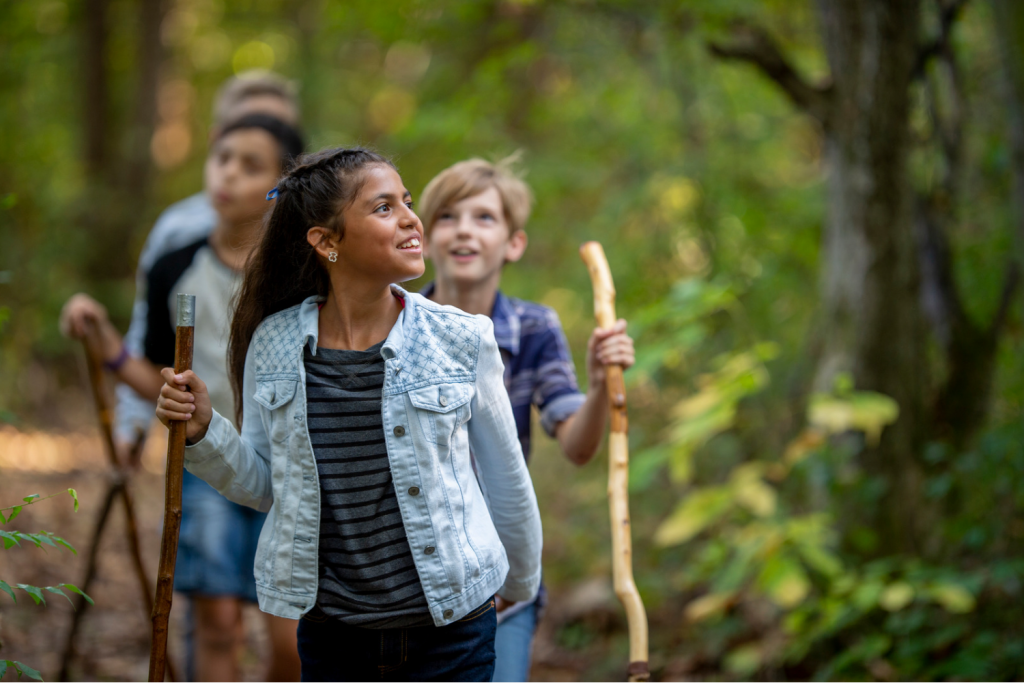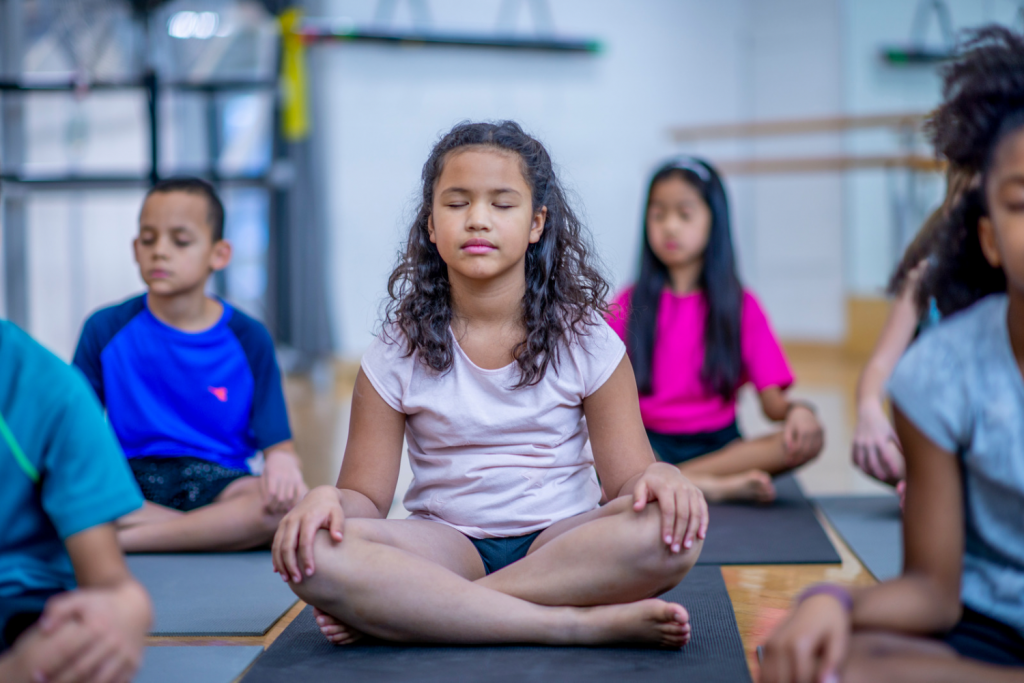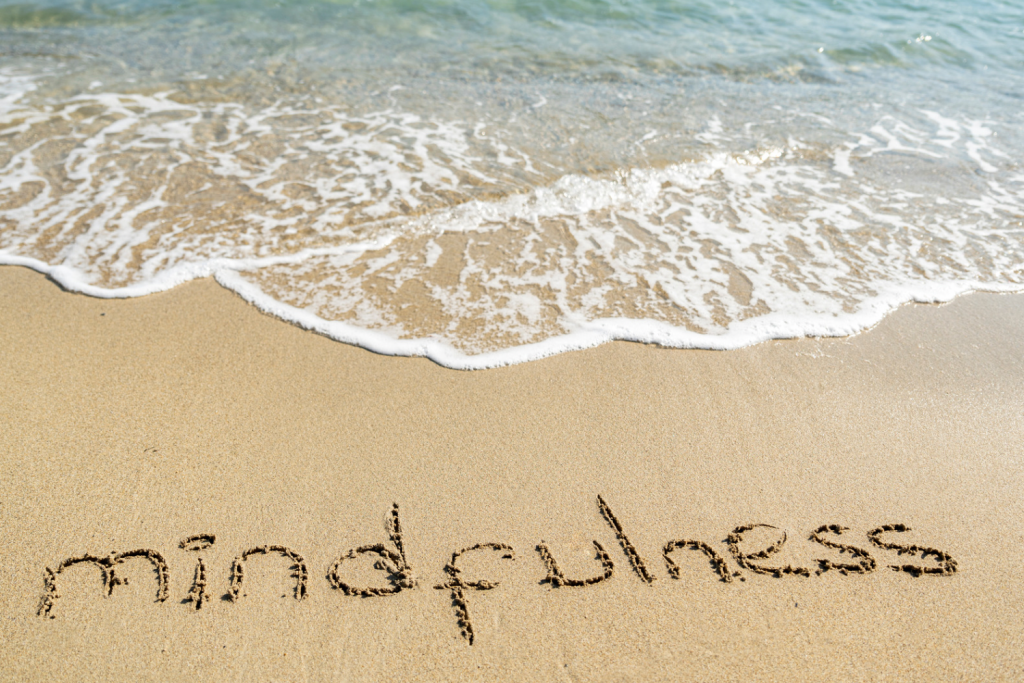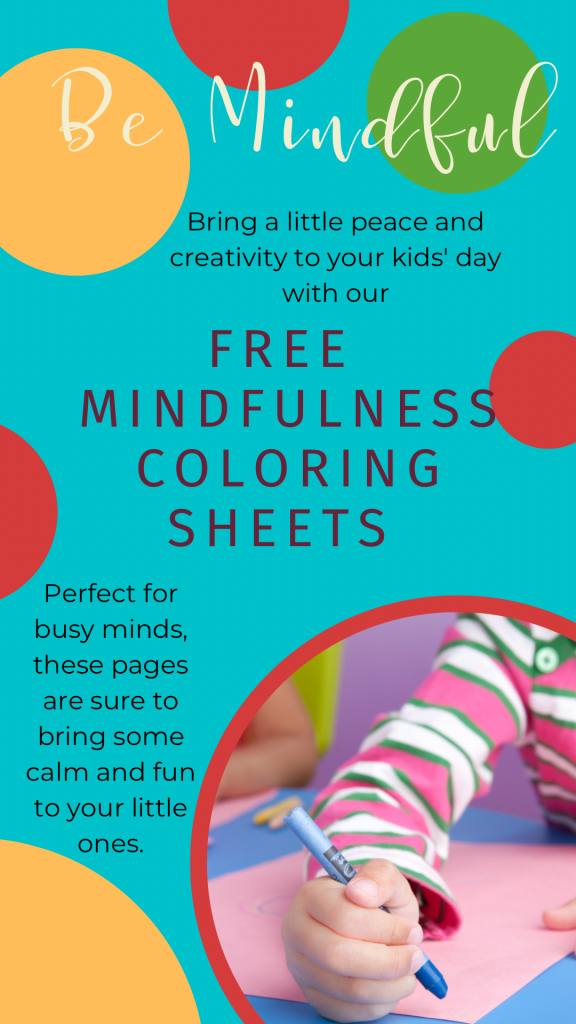Table of Contents
Head to the bottom for the coloring pages!
Do you want to help your children develop healthy minds and positive coping skills? If so, then teaching them to be mindful and use mindfulness activities can be a great way to guide their development. In this blog post, we’ll discuss the benefits of mindfulness for kids, as well as some tips for getting started.
What is Being Mindful?
Being mindful is the practice of being present in the moment, paying attention to one’s thoughts, feelings, and physical sensations without judgment. It is a mental state of awareness, where one is able to observe one’s thoughts and emotions without getting caught up in them. Mindfulness is not about clearing your mind or eliminating thoughts, but rather about observing them with a non-judgmental attitude.
In this way, mindfulness helps individuals to develop a greater sense of self-awareness and improve their ability to manage stress and emotions. Mindfulness differs from meditation in that it is a state of being rather than an activity, and it can be practiced in any moment of the day, not only during a specific time of meditation.
Introducing Mindfulness to Kids
Introducing mindfulness to children can be a great way to help them develop important skills such as self-awareness, emotional regulation, and focus. To start, it’s important to explain to children what mindfulness is in a way that is age-appropriate and easy for them to understand. You can open the discussion by asking them if they have ever noticed their thoughts or feelings and explaining that mindfulness is a way to pay attention to those feelings and thoughts without judgment. You can also use simple and relatable examples such as taking a deep breath when feeling angry or taking a break to observe the nature when feeling overwhelmed.
To help children see the benefits of being mindful, you can encourage them to notice how they feel before and after a mindfulness activity, and how it helps them to feel more calm, peaceful, or in control. Incorporating mindfulness into daily routines, such as meal times, homework, and bedtime, will help children to see the benefits of mindfulness in their daily lives and make it a habit.
Introducing mindfulness to kids can take many forms. Parents can start by teaching their children simple breathing exercises, and then progress to focus on the senses. Active mindfulness activities such as stretches and yoga poses can also be introduced to children. Pretend play like ‘Walking on Thin Ice’ is a great way to get kids excited about mindfulness. Noticing and naming body sensations, thoughts, and emotions helps kids build their mindfulness skills. Parents should also encourage mindful eating, mindful movement, mindful listening, mindful learning, and mindful breathing to further help their children become more aware and present in the moment.
Benefits
Benefits of mindfulness for kids can be seen in many aspects of their development. Studies have found that kids who practice mindfulness are more likely to have better self-control, increased attention, and improved cognitive development.
Additionally, mindfulness can help kids shift their focus from worrying about the past or future to what is happening in the present moment. This can lead to a reduction in anxiety and stress levels and an increase in overall well-being. Practicing mindful activities such as mindful eating, movement, listening, and learning can help children stay in control of their emotions and reactions to things that are out of their control. This can also help them to improve their relationships with others as they learn to be more empathetic and understanding.
Furthermore, mindfulness can help children to develop greater self-awareness and understanding of their own thoughts, feelings and emotions which is a key component of emotional intelligence. By introducing mindfulness to children at an early age, they can learn how to manage stress and regulate their emotions more effectively, allowing them to better face daily challenges and improve their overall mental and physical well-being.
Techniques to Teach Kids Mindfulness
Teaching mindfulness to kids is an essential aspect of helping them develop emotional intelligence and resilience. There are various techniques that can be used to introduce mindfulness to kids, each with its own unique benefits.

For example, the bell listening exercise is a great way to begin practicing mindfulness. This exercise involves having kids focus on paying attention to what they can hear, such as the sound of a bell or a chime. This can help them to develop their ability to focus and pay attention. Another effective activity is the “Pretend to walk on thin ice” which helps children become more mindful and aware of their emotions by encouraging them to imagine walking on thin ice and to pay attention to their feelings and thoughts.
Blowing bubbles is a simple and fun activity that can help teach children how to take deep breaths and focus on the present moment. The act of blowing bubbles requires children to take deep breaths and focus on their breath, which can help them to become more mindful and aware of their breath.
Another technique that can be used to teach mindfulness to children is the acronym STOP: Stop, Take a breath, Observe, and Proceed. This can be used as a reminder for children to take a moment to pause and reflect on their thoughts and feelings before responding to a situation.
Finally, going on a “noticing walk” is a great way for kids to practice being mindful while exploring their environment. This can be done by encouraging children to pay attention to their surroundings and to notice different things such as colors, shapes, and sounds. This activity can help children to develop their sense of curiosity and their ability to focus.
Incorporating these various mindfulness techniques into daily routines and activities can help children to develop emotional intelligence, resilience and self-awareness, which are important skills that they can carry with them throughout their lives.

Using Mindfulness to Reduce Anxiety
Using mindfulness as a tool to reduce anxiety in children is an effective way of helping them cope with stressful life events. Mindfulness practices, such as noticing five things, conscious breathing, and mindful listening, can help children become more aware of their thoughts and feelings, which can be a major source of anxiety. By increasing their awareness, children can begin to manage their emotions more efficiently and develop a greater sense of control over their thoughts and feelings.
Research has shown that incorporating mindfulness practices into a child’s daily routine can lead to significant reductions in stress, depression, and distractibility. Mindfulness can help children to become more aware of their thoughts and feelings, which can be a major source of anxiety. By increasing their awareness, children can begin to manage their emotions more efficiently and develop a greater sense of control over their thoughts and feelings.
Mindfulness also provides children with the tools they need to make better decisions in difficult situations. It can help them to find balance in their lives and to develop a greater sense of self-awareness. This can be extremely beneficial for children who are struggling with anxiety, as it can help them to feel more in control and less overwhelmed by their thoughts and feelings. Mindfulness can also help children to develop a more positive outlook on life and to build more resilient emotional states, which can lead to a decrease in anxiety symptoms.
In summary, mindfulness can be an effective tool for reducing anxiety in children. By teaching children to be more aware of their thoughts and feelings, they can develop the tools they need to manage their emotions more efficiently and find balance in their lives. This can lead to a decrease in anxiety symptoms and an overall improvement in their mental well-being.
Mindful Eating
Introducing mindfulness to the act of eating can be a valuable tool for children to learn how to make healthy food choices and develop a positive relationship with food. Mindful eating involves paying attention to the food we eat, and being fully present in the moment while eating. This can include paying attention to the taste, smell, and texture of the food, as well as being aware of our body’s hunger and fullness signals. By practicing mindful eating, children can learn how to listen to their body’s needs, and make healthy food choices.

One way to start teaching children about mindful eating is by encouraging them to eat slowly and savor their food. This can include taking small bites, chewing food thoroughly, and putting down utensils between bites. Another approach is to encourage children to eat with their non-dominant hand, which can slow down the eating process and make them more aware of what they are eating.
Mindful eating can also involve encouraging children to be aware of the thoughts and feelings that come up while eating. This can include teaching children to recognize and accept thoughts and feelings without judgement, and learning to focus on the present moment.
Overall, mindful eating can be a valuable tool for children to learn how to make healthy food choices and develop a positive relationship with food. By practicing mindful eating, children can learn how to listen to their body’s needs and make healthy food choices, which can lead to a lifetime of healthy habits.
Mindful Movement
Mindful movement refers to a variety of physical activities that are performed with the intention of being present and aware in the moment. These activities can include yoga, tai chi, qigong, and other forms of exercise that focus on breathing, body awareness, and relaxation. The goal of mindful movement is to help individuals become more aware of their physical sensations, thoughts, and emotions, and to learn how to regulate their responses to them.
During a mindful movement practice, individuals are encouraged to pay attention to their breath, the sensation of their body moving, and the present moment. They are also encouraged to focus on the present moment, rather than getting caught up in thoughts about the past or future. Mindful movement can help individuals to release tension, reduce stress, and improve overall well-being.
Mindful movement can also be a way to introduce children to mindfulness practice, as it can be fun and engaging. It can be a good way to teach children how to focus their attention and be present in their bodies, which can help them to be more aware of their thoughts and feelings. Check out this Mindful Bingo Game.
Overall, mindful movement is a form of exercise that combines physical movement with mindfulness practice, which can help individuals to improve their overall well-being and gain a better understanding of their thoughts, feelings and emotions.

Mindful Listening
Mindful listening refers to the practice of actively paying attention to sounds and other auditory inputs in a non-judgmental and present-moment way. The goal of mindful listening is to improve one’s ability to focus, reduce distractions, and increase one’s awareness of their surroundings.
During a mindful listening exercise, individuals are encouraged to pay attention to the sounds around them, such as birds singing, traffic, or people talking. They are also encouraged to listen without trying to interpret or evaluate what they hear. This can help them to better appreciate the sounds they are hearing, and to be more present in the moment.
Mindful listening can also be used as a way to practice mindfulness with children, as it can be a fun and engaging activity. For example, children can be asked to listen to different sounds and identify them, such as different types of birds, or vehicles passing by. This can help them to be more aware of their surroundings, and to develop their listening skills.
In addition, mindful listening can also be used as a stress reduction technique. It can be a good way to release the tension and focus on the present moment, leaving behind the worries and distractions of the day.
Overall, mindful listening is a practice that encourages individuals to pay attention to sounds around them, in a non-judgmental way and focus on the present moment. It can help to improve focus, reduce distractions, increase awareness of surroundings and reduce stress.
Mindful Learning
Mindful learning refers to the practice of incorporating mindfulness techniques into the learning process in order to improve focus, concentration, and overall well-being. Mindful learning aims to help individuals to be more present in the moment, and to be more aware of their thoughts, emotions and physical sensations.
Incorporating mindfulness into the learning process can be done in a variety of ways. One way is to have students practice mindfulness exercises, such as deep breathing or meditation, before or during class. This can help to reduce stress, improve focus and concentration, and increase overall well-being.
Another way to incorporate mindfulness into learning is to encourage students to be present and engaged in the material they are studying. This can be done by encouraging them to take notes, ask questions, and actively participate in class discussions.
In addition to this, mindful learning also includes self-reflection. This allows students to understand their own thought process, emotions, and how they react to different situations. This self-awareness can help them to better understand their own learning style and how they can improve their performance.
Overall, mindful learning is a way to incorporate mindfulness techniques into the learning process to improve focus, concentration, and overall well-being. It helps individuals to be more present in the moment, more aware of their thoughts, emotions, and physical sensations, and encourages self-reflection to understand own learning style.
54321 Mindfulness Exercise
The 54321 mindfulness exercise is a simple and easy-to-use mindfulness technique that can be used by children and adults alike. It helps to focus the mind and bring awareness to the present moment. The exercise is done as follows:
- Find a quiet and comfortable place to sit or stand.
- Close your eyes and take a deep breath in through your nose and out through your mouth.
- Look around and name 5 things you can see in the room.
- Listen and name 4 things you can hear.
- Feel and name 3 things you can feel physically.
- Think and name 2 things you are grateful for.
- Take one more deep breath in through your nose and out through your mouth.
The exercise is easy to follow and it can be done in any place and at any time, this exercise can help to ground you in the present moment, shift focus from worries and distractions, and give a sense of calmness. It’s a good way to teach children to focus their mind and body and become more aware of their surroundings.
The MoshiKids App is a great tool to assist our kids with being more mindful and self regulation.
Being Mindful in Our Daily lives
Bringing mindfulness into our daily lives is a great way to improve overall well-being and reduce stress. Mindfulness practices can be integrated into various aspects of our daily routine such as morning routines, commuting, work, and leisure activities.
One way to incorporate mindfulness into our daily lives is to start the day with a few minutes of mindfulness practice, such as meditation or deep breathing. This can help to set a positive tone for the day and reduce stress levels.
Another way to bring mindfulness into our daily lives is to take a few mindful moments throughout the day. For example, take a few deep breaths during a break at work, or take a moment to focus on the present while waiting in line.
In addition to this, mindful movement such as yoga or tai chi can also be incorporated into our daily routine. It helps to improve focus and concentration, and reduce stress levels.
Another way to bring mindfulness in daily life is to be mindful of our thoughts and emotions. Instead of getting caught up in negative thoughts, we can take a step back, observe and release them.

Ultimately, bringing mindfulness into our daily lives is about taking a few minutes each day to focus on the present moment and to be aware of our thoughts and emotions. It can be done in a variety of ways and can help to reduce stress, improve well-being, and increase overall happiness.
In conclusion, mindfulness is a valuable skill that can help children to manage stress and improve their overall well-being. By introducing mindfulness activities and exercises to kids, parents and caregivers can help them to develop emotional intelligence and resilience. There are many techniques that can be used to teach kids mindfulness, such as the “5-4-3-2-1” exercise, breathing exercises, body scan meditation, mindful listening, and noticing walks.
By bringing mindfulness into their daily lives, children can learn how to manage their emotions and reactions to things that are out of their control. Additionally, mindfulness can help kids shift their focus from worrying about the past or future to what is happening in the present moment. By practicing mindfulness regularly, kids can learn to be more present in the moment, and better equipped to handle the challenges of life. Also remember as parents, it is extremely important for us to practice self care so we can be the best versions of ourselves for our children.
Free Coloring Pages with Mindful Quotes
Click on the image below for your free coloring pages!





❤️